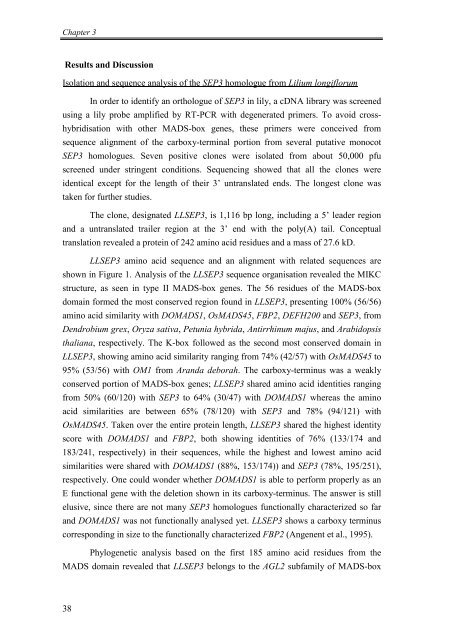Flower development of Lilium longiflorum - The Lilium information ...
Flower development of Lilium longiflorum - The Lilium information ...
Flower development of Lilium longiflorum - The Lilium information ...
Create successful ePaper yourself
Turn your PDF publications into a flip-book with our unique Google optimized e-Paper software.
Chapter 3<br />
Results and Discussion<br />
Isolation and sequence analysis <strong>of</strong> the SEP3 homologue from <strong>Lilium</strong> <strong>longiflorum</strong><br />
In order to identify an orthologue <strong>of</strong> SEP3 in lily, a cDNA library was screened<br />
using a lily probe amplified by RT-PCR with degenerated primers. To avoid cross-<br />
hybridisation with other MADS-box genes, these primers were conceived from<br />
sequence alignment <strong>of</strong> the carboxy-terminal portion from several putative monocot<br />
SEP3 homologues. Seven positive clones were isolated from about 50,000 pfu<br />
screened under stringent conditions. Sequencing showed that all the clones were<br />
identical except for the length <strong>of</strong> their 3’ untranslated ends. <strong>The</strong> longest clone was<br />
taken for further studies.<br />
<strong>The</strong> clone, designated LLSEP3, is 1,116 bp long, including a 5’ leader region<br />
and a untranslated trailer region at the 3’ end with the poly(A) tail. Conceptual<br />
translation revealed a protein <strong>of</strong> 242 amino acid residues and a mass <strong>of</strong> 27.6 kD.<br />
LLSEP3 amino acid sequence and an alignment with related sequences are<br />
shown in Figure 1. Analysis <strong>of</strong> the LLSEP3 sequence organisation revealed the MIKC<br />
structure, as seen in type II MADS-box genes. <strong>The</strong> 56 residues <strong>of</strong> the MADS-box<br />
domain formed the most conserved region found in LLSEP3, presenting 100% (56/56)<br />
amino acid similarity with DOMADS1, OsMADS45, FBP2, DEFH200 and SEP3, from<br />
Dendrobium grex, Oryza sativa, Petunia hybrida, Antirrhinum majus, and Arabidopsis<br />
thaliana, respectively. <strong>The</strong> K-box followed as the second most conserved domain in<br />
LLSEP3, showing amino acid similarity ranging from 74% (42/57) with OsMADS45 to<br />
95% (53/56) with OM1 from Aranda deborah. <strong>The</strong> carboxy-terminus was a weakly<br />
conserved portion <strong>of</strong> MADS-box genes; LLSEP3 shared amino acid identities ranging<br />
from 50% (60/120) with SEP3 to 64% (30/47) with DOMADS1 whereas the amino<br />
acid similarities are between 65% (78/120) with SEP3 and 78% (94/121) with<br />
OsMADS45. Taken over the entire protein length, LLSEP3 shared the highest identity<br />
score with DOMADS1 and FBP2, both showing identities <strong>of</strong> 76% (133/174 and<br />
183/241, respectively) in their sequences, while the highest and lowest amino acid<br />
similarities were shared with DOMADS1 (88%, 153/174)) and SEP3 (78%, 195/251),<br />
respectively. One could wonder whether DOMADS1 is able to perform properly as an<br />
E functional gene with the deletion shown in its carboxy-terminus. <strong>The</strong> answer is still<br />
elusive, since there are not many SEP3 homologues functionally characterized so far<br />
and DOMADS1 was not functionally analysed yet. LLSEP3 shows a carboxy terminus<br />
corresponding in size to the functionally characterized FBP2 (Angenent et al., 1995).<br />
Phylogenetic analysis based on the first 185 amino acid residues from the<br />
MADS domain revealed that LLSEP3 belongs to the AGL2 subfamily <strong>of</strong> MADS-box<br />
38














